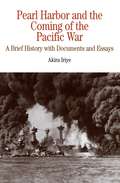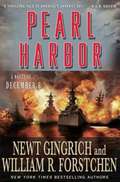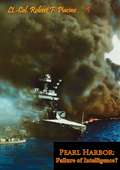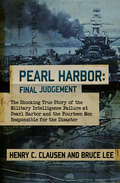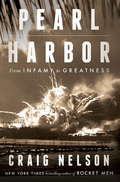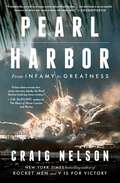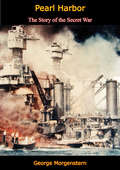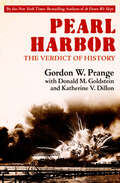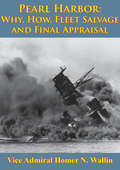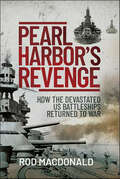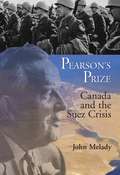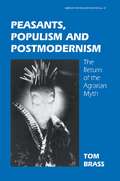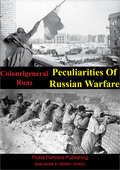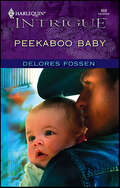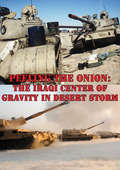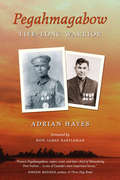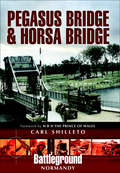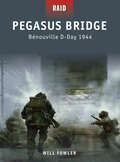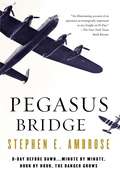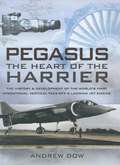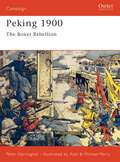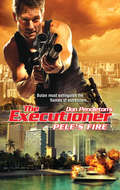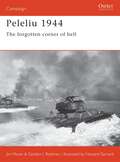- Table View
- List View
Pearl Harbor Is Burning: A Story of World War II (Once Upon America Series)
by Kathleen V. KudlinskiFrank wishes his family had never moved to Hawaii. He has no friends and the local boys taunt him as a haoli , an outsider. When Kenji, a Japanese-American boy, offers friendship, they discover a lot in common, especially a love of baseball. The two boys are in Frank's tree house overlooking Pearl Harbor on December 7, 1941, where they watch with fascination and horror as ship after ship is blown up in the water. Conflicting messages and rumors being broadcast over the radio serve as a background for confusion as people react to the emergency. An effective snapshot of the past, this book presents a realistic picture of what residents of Honolulu experienced on that fateful day.
Pearl Harbor and the Coming of the Pacific War: A Brief History With Documents And Essays (The Bedford Series In History And Culture)
by Akira IriyeAssembling more than 30 primary documents — including proposals, memoranda, decrypted messages, and imperial conferences — Iriye presents diplomatic exchanges from both American and Japanese perspectives to determine how and why the United States and Japan went to war in 1941. <P><P>A detailed introduction provides background on Japanese aggression in China and Southeast Asia during the 1930s and economic unrest and isolationism in the United States. <P><P>Readings add an interpretive dimension, placing Pearl Harbor in global context; essays from American, Japanese, Chinese, Soviet, German, British, and Indonesian perspectives explain how various countries applied pressure, offered assistance, exacerbated rifts, and significantly affected negotiations and Japan’s ultimate decision for war.
Pearl Harbor: A Novel of December 8th (Book One of the Pacific War series)
by Newt Gingrich William R. ForstchenHow could the presence of 1 more man in the Japanese force have changed the Pearl Harbor attack and subsequent war? Alternate historical fiction.
Pearl Harbor: Failure of Intelligence?
by Lt.-Col. Robert F. PiacineMany scholars and writers state that the surprise the Japanese achieved in their attack on Pearl Harbor resulted from a failure of the U.S. intelligence community to provide adequate, accurate information to government and military decision-makers. These historians presume the intelligence community possessed critical information that was misinterpreted or not appropriately disseminated prior to the attack. Some revisionist historians also subscribe to conspiracy theories and believe that key members of the U.S. government purposely withheld this critical information from the military command in an effort to bring the U.S. into World War II against the Axis powers....A review of the evidence available from official, public, and private sources, however, indicates these viewpoints are inaccurate. At best they reflect a lack of understanding of the collection capabilities and information available to the U.S. intelligence community before Pearl Harbor; at worst these views are an effort to rewrite history. It is possible to disprove these allegations, however, by examining the history of the U.S. intelligence community prior to the attack; its intelligence collection capabilities; the success or failure of the collection effort; its knowledge of Japanese military preparations for offensive activity; and the utilization of that information by national and military decision-makers.The lessons of Pearl Harbor are too valuable to be lost to misinterpretation or revisionism. They provide the basis for teaching future generations of government and military leaders the importance of national preparedness and the proper use of intelligence. Without a clear understanding, future leaders may be doomed to repeat the mistakes of the past--an error of major proportions during this time of military downsizing and decreasing power projection capabilities.
Pearl Harbor: Final Judgement
by Henry C. Clausen Bruce Lee"We might have possessed the genius to break the Purple code, but in 1941 we didn't have the brains to know what to do with it." --Henry C. Clausen, special investigator for secretary of war Henry L. Stimson On December 6, 1941, Admiral Husband E. Kimmel, commander in chief of the United States Pacific Fleet, assured his staff that the Japanese would not attack Pearl Harbor. The next morning, Japanese carriers steamed toward Hawaii to launch one of the most devastating surprise attacks in the history of war, proving the admiral disastrously wrong. Immediately, an investigation began into how the American military could have been caught so unaware. The results of the initial investigation failed to implicate who was responsible for this intelligence debacle. Secretary of War Henry L. Stimson, realizing that high-ranking members of the military had provided false testimony, decided to reopen the investigation by bringing in an unknown major by the name of Henry C. Clausen. Over the course of ten months, from November 1944 to September 1945, Clausen led an exhaustive investigation. He logged more than fifty-five thousand miles and interviewed over one hundred military and civilian personnel, ultimately producing an eight-hundred-page report that brought new evidence to light. Clausen left no stone unturned in his dogged effort to determine who was truly responsible for the disaster at Pearl Harbor. Pearl Harbor: Final Judgement reveals all of the eye-opening details of Clausen's investigation and is a damning account of massive intelligence failure. To this day, the story surrounding the Japanese attack on Pearl Harbor stokes controversy and conspiracy theories. This book provides conclusive evidence that shows how the US military missed so many signals and how it could have avoided the events of that fateful day.
Pearl Harbor: From Infamy to Greatness
by Craig NelsonOn 7 December 1941, an armada of 354 Japanese warplanes launched a surprise attack on the United States, killing 2,403 people and forcing America's entry into the Second World War. With vivid prose and astonishing detail, Craig Nelson combines thrilling historical drama with individual concerns and experiences, following an ensemble of sailors, soldiers, pilots, diplomats, admirals, generals, the emperor and the president.Unmatched in breadth and depth, Pearl Harbor: From Infamy to Greatness in a portrait of the terror, chaos, violence and tragedy of the attack that would prove to be a turning point of the war.
Pearl Harbor: From Infamy to Greatness
by Craig NelsonPublished in time for the 75th anniversary, a gripping and definitive account of the event that changed twentieth-century America--Pearl Harbor--based on years of research and new information uncovered by a New York Times bestselling author.The America we live in today was born, not on July 4, 1776, but on December 7, 1941, when an armada of 354 Japanese warplanes supported by aircraft carriers, destroyers, and midget submarines suddenly and savagely attacked the United States, killing 2,403 men--and forced America's entry into World War II. Pearl Harbor: From Infamy to Greatness follows, moment by moment, the sailors, soldiers, pilots, diplomats, admirals, generals, emperor, and president as they engineer, fight, and react to this stunningly dramatic moment in world history. Beginning in 1914, bestselling author Craig Nelson maps the road to war, beginning with Franklin D. Roosevelt, then the Assistant Secretary of the Navy (and not yet afflicted with polio), attending the laying of the keel of the USS Arizona at the Brooklyn Navy Yard. Writing with vivid intimacy, Nelson traces Japan's leaders as they lurch into ultranationalist fascism, which culminates in their insanely daring yet militarily brilliant scheme to terrify America with one of the boldest attacks ever waged. Within seconds, the country would never be the same. In addition to learning the little understood history of how and why Japan attacked Hawaii, we hear an abandoned record player endlessly repeating "Sunrise Serenade" as bombs shatter the decks of the California; we feel cold terror as lanky young American sailors must anxiously choose between staying aboard their sinking ships or diving overboard into harbor waters aflame with burning ship fuel; we watch as Navy wives tearfully hide with their children in caves from a rumored invasion, and we understand the frustration and triumph of a lone American teenager as he shoots down a Japanese bomber, even as the attack destroys hundreds of US airplanes and dozens of ships. Backed by a research team's five years of work, which produced nearly a million pages of documents, as well as Nelson's thorough re-examination of the original evidence assembled by federal investigators, this page-turning and definitive work provides a thrilling blow-by-blow account from both the Japanese and American perspectives, and is historical drama on the grandest scale. Nelson delivers all the terror, chaos, violence, tragedy, and heroism of the attack in stunning detail, and offers surprising conclusions about the tragedy's unforeseen and resonant consequences that linger even today.
Pearl Harbor: The Story of the Secret War
by George MorgensternFirst published in 1947, Pearl Harbor: The Story of the Secret War is widely regarded as the first Revisionist book about the attack on Pearl Harbor on December 7, 1941, and the complex history which preceded and followed it.Although it drew both criticism and praise on its initial release, this book covers many aspects of that war, its antecedents and its consequences, and ranks among the best of the numerous volumes published on the subject.“Those who object to historical skepticism may complain that my book is no contribution to the political canonization of its central figure. That is no concern of mine. As to the purpose my book is intended to serve, some observations from the minority report of the Joint Congressional Committee which investigated the Pearl Harbor attack are pertinent: ‘In the future the people and their Congress must know how close American diplomacy is moving to war so that they may check in advance if imprudent and support its position if sound ... How to avoid war and how to turn war -- if it finally comes -- to serve the cause of human progress is the challenge to diplomacy today as yesterday.’“—George Morgenstern
Pearl Harbor: The Verdict of History
by Gordon W. Prange Donald M. Goldstein Katherine V. DillonThe New York Times–bestselling authors of Miracle at Midway delve into the surprise attack on Pearl Harbor during WWII in &“a superb work of history&” (Albuquerque Journal Magazine). In the predawn hours of December 7, 1941, a Japanese carrier group sailed toward Hawaii. A few minutes before 8:00 a.m., they received the order to rain death on the American base at Pearl Harbor, sinking dozens of ships, destroying hundreds of airplanes, and taking the lives of over two thousand servicemen. The carnage lasted only two hours, but more than seventy years later, terrible questions remain unanswered. How did the Japanese slip past the American radar? Why were the Hawaiian defense forces so woefully underprepared? What, if anything, did American intelligence know before the first Japanese pilot shouted &“Tora! Tora! Tora!&”? In this incomparable volume, Pearl Harbor experts Gordon W. Prange, Donald M. Goldstein, and Katherine V. Dillon tackle dozens of thorny issues in an attempt to determine who was at fault for one of the most shocking military disasters in history.
Pearl Harbor: The Verdict of History (The\warriors Ser.)
by Gordon W. Prange Donald M. Goldstein Katherine V. DillonThe New York Times–bestselling authors of Miracle at Midway delve into the surprise attack on Pearl Harbor during WWII in &“a superb work of history&” (Albuquerque Journal Magazine). In the predawn hours of December 7, 1941, a Japanese carrier group sailed toward Hawaii. A few minutes before 8:00 a.m., they received the order to rain death on the American base at Pearl Harbor, sinking dozens of ships, destroying hundreds of airplanes, and taking the lives of over two thousand servicemen. The carnage lasted only two hours, but more than seventy years later, terrible questions remain unanswered. How did the Japanese slip past the American radar? Why were the Hawaiian defense forces so woefully underprepared? What, if anything, did American intelligence know before the first Japanese pilot shouted &“Tora! Tora! Tora!&”? In this incomparable volume, Pearl Harbor experts Gordon W. Prange, Donald M. Goldstein, and Katherine V. Dillon tackle dozens of thorny issues in an attempt to determine who was at fault for one of the most shocking military disasters in history.
Pearl Harbor: Why, How, Fleet Salvage And Final Appraisal (Illustrated Edition)
by Vice Admiral Homer N. Wallin Rear Admiral Ernest McNeill Eller USN<P>Illustrated with more than 50 photos. <P>Pearl Harbor will long stand out in men's minds as an example of the results of basic unpreparedness of a peace loving nation, of highly efficient treacherous surprise attack and of the resulting unification of America into a single tidal wave of purpose to victory. Therefore, all will be interested in this unique narrative by Admiral Wallin. <P>The Navy has long needed a succinct account of the salvage operations at Pearl Harbor that miraculously resurrected what appeared to be a forever shattered fleet. Admiral Wallin agreed to undertake the job. He was exactly the right man for it - in talent, in perception, and in experience. He had served intimately with Admiral Nimitz and with Admiral Halsey in the South Pacific, has commanded three different Navy Yards, and was a highly successful Chief of the Bureau of Ships. <P>On 7 December 1941 the then Captain Wallin was serving at Pearl Harbor. He witnessed the events of that shattering and unifying "Day of Infamy." His mind began to race at high speeds at once on the problems and means of getting the broken fleet back into service for its giant task. Unless the United States regained control of the sea, even greater disaster loomed. Without victory at sea, tyranny soon would surely rule all Asia and Europe. In a matter of time it would surely rule the Americas. <P>Captain Wallin salvaged most of the broken Pearl Harbor fleet that went on to figure prominently in the United States Navy's victory. So the account he masterfully tells covers what he masterfully accomplished. The United States owes him an unpayable debt for this high service among many others in his long career.
Pearl Harbor’s Revenge: How the Devastated U.S. Battleships Returned to War
by Rod Macdonald"...informative and detailed with some interesting and little-known anecdotes as well." — National Maritime Historical Society.Early on Sunday, 7 December 1941, Japanese carrier-borne aircraft launched a surprise attack against the US Pacific Fleet based at Pearl Harbor. It was a date that President Roosevelt declared “will live in infamy”. During the strike, Japanese planes attacked the seven US battleships lined up in Battleship Row – and the flag battleship USS Pennsylvania, in drydock for overhaul. The battleship USS Arizona exploded from a bomb hit at the forward magazine killing 1,177 officers and men. On USS Oklahoma, 429 men were killed – many trapped inside as the great battleship capsized after aerial torpedo strikes. USS West Virginia, meanwhile, was hit by at least seven torpedoes and several bombs, and engulfed in flames; she settled onto the bottom on an even keel. USS California was hit by a pair of torpedoes and a bomb, flooding slowly, she too settled on the bottom. The other four battleships present were more lightly damaged, with the crippled Nevada, the only battleship to get underway during the attack, being successfully beached. By the time the assault was over, eight battleships, three light cruisers, three destroyers, a training ship and other smaller vessels had been sunk or damaged. Hundreds of US aircraft had been damaged or destroyed, while 2,403 Americans had been killed. Within a week of the Japanese attack, a great salvage organization had been formed. Very quickly the lightly damaged battleships Pennsylvania, Maryland and Tennessee had been repaired in naval yards and put back into service to protect the west coast of the USA. Of the eight battleships attacked, all but Arizona were raised, temporarily patched-up and sent back to naval yards on the west coast of America for final repair and modernization. Main battery guns and ordnance were recovered from the wrecked Arizona, which would then be left to rest on the bottom of the harbor for eternity – as a memorial to the events of that fateful December day. USS Nevada was lifted off the bottom in February 1942, California in March 1942 and West Virginia in June 1942. The capsized Oklahoma, while eventually parbuckled and raised, was found to be too badly damaged to be fully rebuilt. Six of the eight battleships would thus return to service, with improved protection against bombs and torpedoes and being fitted with the latest anti-aircraft and gunnery systems. They would re-enter to the war to wreak a terrible revenge – making their presence felt during the reconquest of the Aleutian Islands and the Philippines, and the great battles of Leyte Gulf, Iwo Jima and Okinawa. Nevada would go on Atlantic convoy duty before bombarding German positions off Utah beach as the D-Day Normandy landings began. This is the story of those six.
Pearson's Prize
by John MeladyIn the fall of 1956, the world was on the brink of war. Egyptian President Gamel Nasser nationalized the Suez Canal, and Britain, France, and Israel attacked him. Russia supported Nasser, and Soviet Premier Khrushchev threatened nuclear holocaust if the United States became militarily involved. Soon, the matter became a major problem for the United Nations.Fortunately, because of the efforts of Lester Pearson, then Canada’s Minister of External Affairs, the crisis was defused. Pearson proposed a U.N. peacekeeping force be sent to Egypt to separate the warring factions there and keep the peace. Because his idea was adopted, Pearson helped save the world from war. For his outstanding statesmanship, Pearson won the Nobel Prize for Peace, the only Canadian ever to do so. This book, written to commemorate the fiftieth anniversary of the event, is about the Suez and about Pearson’s work during a tension-filled time in the twentieth century.
Peasants, Populism and Postmodernism: The Return of the Agrarian Myth
by Dr Tom BrassTracing the way in which the agrarian myth has emerged and re-emerged over the past century in ideology shared by populism, postmodernism and the political right, the argument in this book is that at the centre of this discourse about the cultural identity of 'otherness'/ 'difference' lies the concept of and innate 'peasant-ness'. In a variety of contextually-specific discursive forms, the 'old' populism of the 1890s and the nationalism and fascism in Europe, America and Asia during the 1920s and 1930s were all informed by the agrarian myth. The postmodern 'new' populism and the 'new' right, both of which emerged after the 1960s and consolidated during the 1990s, are also structured discursively by the agrarian myth, and with it the ideological reaffirmation of peasant essentialism.
Peculiarities Of Russian Warfare
by Colonelgeneral Erhard Ruas"PECULIARITES OF RUSSIAN WARFARE" was prepared by a committee of former German generals and general staff corps officers at the EUCOM Historical Division Interrogation Enclosure, Neustadt, Germany, in late 1947 and early 1948. All members of the committee, however, had extensive experience on the Eastern Front during the period 1941-45. The principal author, for example, commanded, in succession, a panzer division, a corps, a panzer army, and an army group."...the report has had to be limited to a description of the characteristic traits of the Russian soldier, and their influence on the conduct of battle. The extent to which the political, economic, and social conditions of the country wore influential factors, could only be touched upon. Orientation concerning climate and terrain-indispensable to an understanding of the Russian methods of warfare-has been omitted intentionally, since pertinent points on those subjects are discussed elsewhere."In order to make the peculiarities of Russian 'warfare more comprehensible, numerous examples, varying according to place, time, and nature, are incorporated in this study. From these examples, conclusions can be drawn concerning not only Russian behavior, but also German countermeasures and experiences."
Peekaboo Baby
by Delores FossenPLAYING PEEKABOO HAS NEVER BEEN SO DEADLYMonths after the birth of her son, single momDelaney Nash discovered a horrible truth: the spermbank she'd used was under investigation for unethicalpractices. Complicating matters even further wasthe very real possibility her son's father was noneother than Ryan McCall—her sworn enemy.Suddenly a string of suspicious—and near-fatal—accidents proved that Delaney and her son were interrible danger. And the only man she could trust tohelp her uncover the truth was the very same manwho was strictly off-limits.And now, in a race against time, could Delaney andRyan combat danger—and their stormy past—before it was too late?
Peeling The Onion: The Iraqi Center Of Gravity In Desert Storm
by Major Collin A. AgeeThis monograph examines the concept "center of gravity" as applied by coalition forces during Operation Desert Storm. Center of gravity is an integral part of operational art and figures prominently in current U.S. doctrine.It begins by tracing the concept's inception in Clausewitz's On War, finding several competing definitions in various sections of that landmark work. Current U.S. doctrine reveals that time has done little to alleviate the confusion. The U.S. Army definition of center of gravity as a strength is significantly and irreconcilably different from the Marine Corps' treatment as a weakness. The Air Force offers yet another slant.Given those inconsistent definitions, it is little wonder that various participants and analysts suggest differing centers of gravity during Desert Storm. From various sources, the monograph compiles a list of a dozen contenders for the title "Iraqi Center of Gravity." It next examines coalition planning and actual combat action in search of a de facto center of gravity, concluding that the Republican Guard was the true Iraqi center.The monograph then suggests The Onion Model as a unifying representation of the concept. Adding the terms Protectors, Connectors and Sustainers to the Center of Gravity, it graphically portrays the relationship of the other eleven contenders to the true center of gravity.The study concludes that the center of gravity remains a valuable, if misused, concept. In Desert Storm, this misapplication of doctrine was overcome by an abundance of combat power; the center was hit because everything was attacked. In the future, U.S. forces may not enjoy the same luxury of time and resources. A future doctrine based on overwhelming force must be tempered by the Law of War's requirements for military necessity, proportionality, and avoidance of unnecessary suffering.
Pegahmagabow: Life-Long Warrior
by Adrian HayesFrancis Pegahmagabow was a remarkable aboriginal leader who served his nation in time of war and his people in time of peace. In wartime he volunteered to be a warrior. In peacetime he had no option. His life reveals how uncaring Canada was about those to whom this land had always been home. A member of the Parry Island band (now Wasauksing First Nation) near Parry Sound, Ontario, Francis served with the Canadian Expeditionary Force in Belgium and France for almost the entire duration of the First World War, primarily as a scout and sniper. Through the horrific battles and inhumane conditions of trench warfare, his actions earned him three decorations for bravery — the most ever received by a Canadian aboriginal soldier. More recently, they inspired the central fictional character in Joseph Boyden’s highly acclaimed novel Three Day Road. Physically and emotionally scarred by his wartime ordeals, Francis returned to Parry Island to try to rebuild his life. He had been treated as an equal in the army, but quickly discovered things hadn’t changed back in Canada. As a status Indian his life was regulated by the infamous Indian Act and by local Indian agents who seemed bent on thwarting his every effort to improve his lot. So, Francis became a warrior once more — this time in the even longer battle to achieve the right of aboriginal Canadians to control their own destiny. In compiling this account of Francis Pegahmagabow’s remarkable life, Adrian Hayes conducted extensive research in newspapers, archives, and military records, and spoke with members of Pegahmagabow’s family and others who remembered the plight and the perseverance of this warrior.
Pegasus Bridge & Horsa Bridge (Battleground Normandy)
by Carl ShilletoThis battlefield guide is the companion work to Merville Battery & The Dives Bridges. Together, these two books form the fully revised and updated edition of the previous best selling Battleground Europe Series book Pegasus Bridge & Merville Battery.This book examines, in great detail, the attack by 2 Oxf Bucks and engineers of the British 6th Airborne Division, in six gliders, on the Caen Canal and River Orne bridges in the early hours of D-Day, 6 June 1944. It also describes part of the battle for the village of Bnouville by 7 Para and Ranville by 13 Para. It was the combination of these actions that allowed the link-up between the commandos and airborne troops on D-Day. Thereby, forming a bridgehead to help secure the eastern flank of the greatest combined military operation in history; Operation OVERLORD.In addition to explaining how these objectives were achieved, this battlefield guide relates the battles to the area as it is today. The book contains details of the museums, memorials, cemeteries and associated organizations. All of which will unravel the history of the area to the visitor and armchair traveler alike.To further aid the battlefield tourist, GPS data is also provided for either satellite navigation by vehicle or for viewing on Google Earth.
Pegasus Bridge - Benouville D-Day 1944
by Johnny Shumate Will FowlerThe night before D-Day, light infantry and a detachment of Royal Engineers landed by gliders at Pegasus Bridge, which spanned the Caen Canal. Quickly overwhelming the guards, they managed to hold the bridge and help prevent German reinforcements from reaching the British landing beaches. Will Fowler provides a detailed blow-by-blow account of this classic wartime raid.
Pegasus Bridge: D-Day -- The Daring British Airborne Raid
by Stephen E. AmbroseIn the early morning hours of June 6, 1944, a small detachment of British airborne troops stormed the German defense forces and paved the way for the Allied invasion of Europe. Pegasus Bridge was the first engagement of D-Day, the turning point of World War II.This gripping account of it by acclaimed author Stephen Ambrose brings to life a daring mission so crucial that, had it been unsuccessful, the entire Normandy invasion might have failed. Ambrose traces each step of the preparations over many months to the minute-by-minute excitement of the hand-to-hand confrontations on the bridge. This is a story of heroism and cowardice, kindness and brutality—the stuff of all great adventures.
Pegasus, the Heart of the Harrier: The History & Development of the World's First Operational Vertical Take-off & Landing Jet Engine
by Andrew DowThis volume chronicles the making of the Harrier Jump Jet—the innovative Cold War fighter aircraft designed to operate from virtually anywhere. In 1957, the British engine manufacturer Bristol Siddeley turned aircraft design on its head with the creation of the Pegasus engine. Until then, aircraft designs would seek out suitable engines. Now the Pegasus was an engine in search of a suitable aircraft. The result was the famous Hawker Siddeley Harrier, the first military airplane capable of vertical takeoff and landings. To this day, Harrier Jump Jets are still in front-line service with air forces around the world including the Royal Air Force and US Marine Corps. In this volume, former Bristol Siddeley executive Andrew Dow offers an in-depth look at the Pegasus engine's original design concept, production and flight testing. Dow then covers the developments and improvements that have been made over the years. He also includes experiences of operational combat flying, both from land and sea. Written in straightforward prose that avoids technical jargon, Pegasus, The Heart of the Harrier is copiously illustrated with many previously unseen photographs and diagrams.
Peking 1900
by Peter Harrington Michael PerryOsprey's study of the violent Boxer Rebellion, which swept northern China in 1900. The Boxers were a secret society who sought to rid their country of the pernicious influence of the foreign powers who had gradually acquired a stranglehold on China. With the connivance of the Imperial Court they laid siege to the legation quarter of Peking. Trapped inside were an assortment of diplomats, civilians and a small number of troops. They were all Sir Claude Macdonald, the British Minister in Peking, had to defend against thousands of hostile Boxers and Imperial troops. It would now be a race against time. Could the rag-tag defenders hold out long enough for the gathering relief force to reach them? This book describes the desperate series of events as the multinational force rushed to their rescue.
Pele's Fire
by Don PendletonWhen six U.S. naval officers disappear inexplicably while on leave in Honolulu, Mack Bolan is suspicious. Then an informant emerges from the Hawaiian underground with claims that a nationalist group has escalated its home-rule rhetoric to militant action. He claims Pele's Fire is planning a devastating terrorist attack somewhere on the islands. There aren't any obvious links between the two events, but Bolan spots a potentially deadly chain.The masterminds of terror are desperate to eradicate any possibility the traitor who has cooled to their cause will keep them from executing their shocking plan. It's up to Bolan to protect the informant and stop the attack--making the Executioner both hunter and prey.
Peleliu 1944
by Howard Gerrard Jim MoranEqualling Tarawa, Iwo Jima and Okinawa in scale and ferocity, the battle for Peleliu has long been regarded as the Pacific War's "forgotten battle", and perhaps one that should never have been fought. A massive carrier-based attack some weeks before the invasion destroyed all aircraft and shipping in the area and virtually isolated the Japanese garrison. 1st Marine Division commander, General Rupertus, made extravagant claims that the capture of Peleliu would "only take three days - maybe two." But the Japanese fought a bloody battle of attrition from prepared positions an in a struggle of unprecedented savagery a whole Marine Division was bled white.

